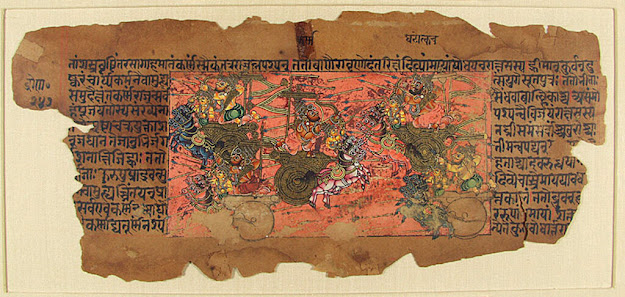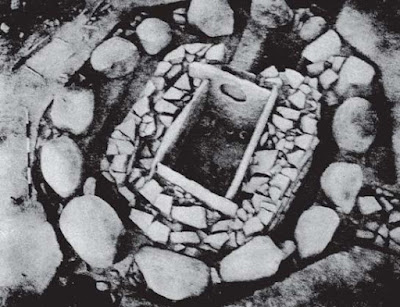INFORMATION ON SOCIAL AND POLITICAL HISTORY FROM SAUPTIKAPARVAN, THE BOOK TEN OF MAHABHARATA.
INFERENCE ABOUT SOCIETY
Firstly, there is evidence of social hierarchy based on Varnashrama dharma is present in the society. There is evidence of certain roles which are assigned particular to the people pertaining to their varna based on their birth. As evidenced from the text where Sanjaya explaining the wrong deed of Ashvatthaman due to change of his duty. As he explains that the Lord of all being on creating every creature, alloted to each his role and as distributor of qualities, he allocated to each different class a particular quality. However, there are notes to breach in this system as for example we see in case of Ashvatthaman who is Brahmin-ritual and educational expert- by birth, but Kshatriya warrior-by training and livelihood. Also as we see his father Dronacharya who is the teacher of kshatriyas, thus showing that both the varnas somewhere come equal in the social ladder in the society.
However, there is also evidence of inter-marriages in the varna system, for example Suta as class developing due to intermarriage between Brahmin and Kshatriya. Since, this mixed class was given the role of chariotter or like a bard acting as an advisor like person etc can be seen subordinate to what is called brahmin and kshatriya roles. But how far such inter marriages were accepted in the society can not defined by this but the demeaning role show some kind of reluctance on this part. However, in contrast we know krishna was a suta in the text. But we do see some kind of acceptance between marriages between upper caste men and women as for example Dhritarashtra who has one son Yuyutsu by Sughada who was a Dasi, i.e a maid but Yuyutsu still enjoyed the status of kshatriya. Also, we know from the text that Dhritarashtra himself was son from sage Vyasa who in turn is son of Satyavati a fisherwoman when young and Parashara who was a sage.
Also slavery is seen to be persistent and the evidence that they were among the lowest
ladder of society is there but what was their actual position and status probably can not
be determined as we do see existent of Dasa and Dasi also there is system of people
loosing in battle becoming a slave is evident from the text when Dhritrarashtra declares
to Sanjaya of becoming slave of Pandu sons after the death of the Duryodhana.
As far as the role of women is concerned, since the text is mainly from the point of
kshatriya and brahmin male their voice is subsumed and the text is silent on their role
and status in society. But certainly the Sauptikaparvan do not show any woman who is
directly in power in the state. Another emphasis on the low status of women in the
society can be seen from the example of marriage of Draupadi from Pandavas where
she gets divided as food among the Pandavas with hers being no say in her marriage.
But in contrast we do see some power dynamics being in their hand once they became
part of the family as it was the Kunti who divided her unintentionally but her words were
accepted by Pandavas. Also, in the later part of the story, Draupadi herself is seen with
some authority in her family when she asks Bheem to bring the blood of Duryodhana for
washing down of her hair.
Also, it can be seen that Monogamy was the desired system of marriage though no doubt
there are evidences of polygamous marriage to be common in the context of kings and
princes having more then one wives. But, how much this was true for common people
can not be analysed clearly from the text. Also polyandry is present as Draupadi
marrying the pandavas. However, how far it was accepted in the society is a point of
question as we do see as argued by Crosby, that there is an explanation in the sense of
justifying monoandry by claiming pandavas to be manifestation of Indra.
There are also some clear evidence from the text about some general notions and
practices pertaining to Indian society. Like there is a focus on discipline and divine will
for fulfillment of one’s duty and Dharma to be defined as work to be done in a pure state
of mind which we see in the narration of Sanjaya to Dritharashtra about the act of
Ashvatthaman who kills the sleeping Panchalas. Also, the practice of keeping hair loose
as sign of mourning is often presented here, evidenced from the act of Ashvatthaman
and Draupadi who loosed their on hearing the death of their dearest, former on the
death of Dronacharya and the later on the death of Panchalas.
POLITY
As far as polity is concerned we know that it is kind of monarchical state polity as even
in the same family there is a war between cousins where there treachery entails
patricide, fratricide and the murder of teachers for the throne. Also, indication of so
many war like clans like Kripa of Gotama, Kritavarman of Satvat clan etc taking part in
the fight of Pandavas and Kauravas shows that the kingdom was stretched conquering
so many warring clans.
Also there is evidence of kingdom having power accumulated at centre as the polity
seems to be large and highly prosperous and only a centralised kind of political
structure can have such kind of components as there might be a system of surplus
production as we have the evidence of land being tilled from the statement of Kripa. The
evidence of prosperity is also reflected from the use precious metals and objects of
Gold in the text. For example the weapons used by the warriors were made of precious
metals like the mace of the Duryodhana made of Gold also the statement of Kripa that
the Brahmins former attended the dead Duryodhana in hope of wealth, 3 also evidence
of Kambojan horse dressed in golden trappings and chariot encrusted with precious
stones fashioned by the crafters reflects the prosperity of the Empire which only an
Organised state structure can posses.
There is evidence of kingdom achieving excellence in developing weapons of mass
destruction as evidence of the Gandiva bow having the potential to devastate the entire
country. We know from other sections of Mahabharata that this bow was provided by
Agni God, the symbol of fire, also the science of making the bow was only with the
Brahma shows specialised people skilled in science. Also if we associate it with the
contemporary world we know the nuclear weapons having such mass scale destruction
produce fire in large amount on the nuclear reaction and we know it requires a great
deal of specialisation. Thus the existence of such type of weaponry is not possible for
small state structure.
The evidence of law books to guide the people in the society is another very important
aspect of an organised state structure. As from the statement of Sanjaya we do see that
there might be idea of punishing those who didn’t work according to whatever
prescribed in the law books. His statement that whoever disregards the injunction found
in the law books and sets out to kill in violation of them has fallen from the path of good
and is driven onto the path of evil. 4 However, this doesn’t define properly if it was only in
spiritual sense or some kind of mechanism was there in place for working of such
system like bureaucracy.
Another aspect of a well defined state structure is the evidence of dating system which
is very important for a progressive society to work. As there is evidence of new era the
kali yuga beginning with the birth of the sole male heir to the Pandava-Kaurava line
Parikshit and ending of the Dvapara yuga with the mass scale killing by Ashvatthaman
of the Panchalas. This also indicates the era being defined pertaining to birth and death
of rulers thus legitimize their authority. Also this kind of changing of yuga to kaliyuga
also somewhere indicate that such kind of patrinial and large scale war was very
uncommon for the society before moving forward to highly competitive state society.
Thus, it can be concluded from the text of Sauptikaparvan that the society and polity was
rather complexed as in comparison to what is actually presumed to be for the vedic era
which is seen as a tribal society. Since, the central theme of the story is revenge
pertaining to fight between a family for power in a major ruling clan, little reference and
that too indefinetly can be defined here. Also, the story being an epic no concrete
reference of it can be derived on contemporary society or the time period of which it is
talking about. Keeping this in mind we do resemblance of some social and political
aspect which we find in today’s society, like the presence of social differentiation, the
legitimation of varnaashrama dharma, the preference to monoandry but then reflection
of monogamy being common among upper caste, the symbols of mourning, evidence of
caste like society, some kind of centralised state structure, concept of becoming slave
after loss in battle etc. However, one thing which can be marked out is that the text is
mostly concerned about the ruling clan and the aristocracy and put very little glimpses
upon the other strata of society. Thus, it becomes looking the society and the polity from
the top down approach where a large mass of society is still unapproached and
non-discussed.
BIBLIOGRAPHY:
Kate Crosby translated Mahabharata, Book 1 0: Dead of Night, (Sauptikaparvan), published by New York University Press and JJC Foundation, 2009.




Comments
Post a Comment